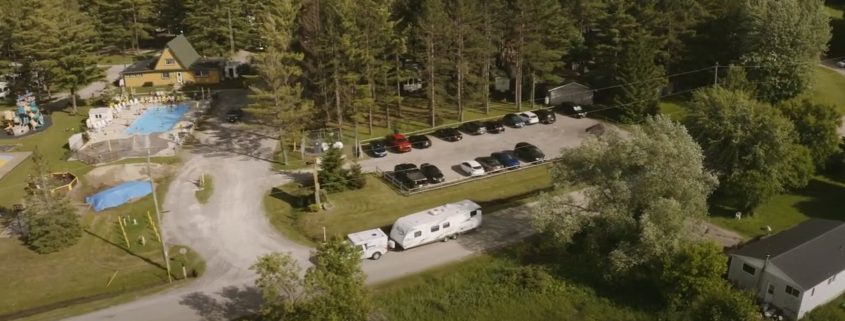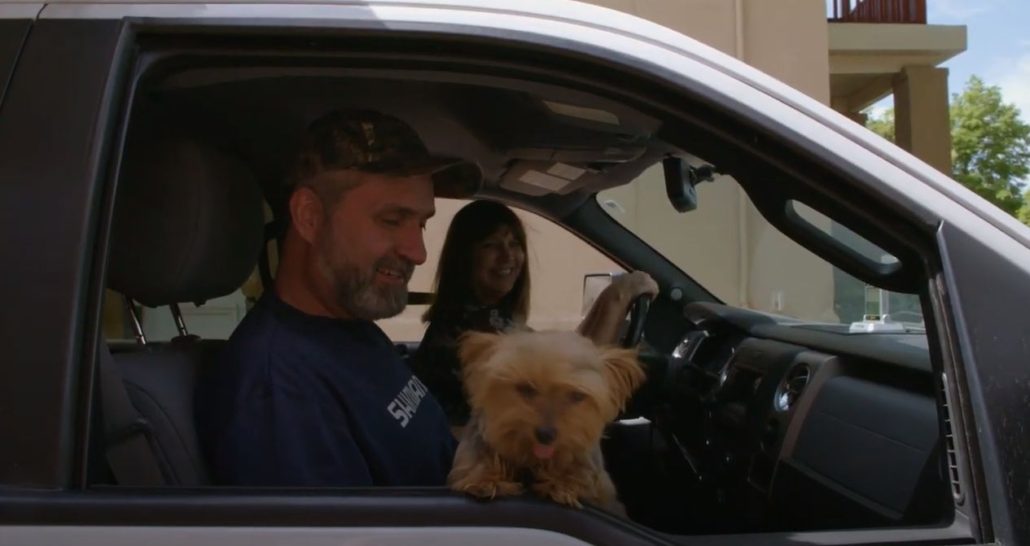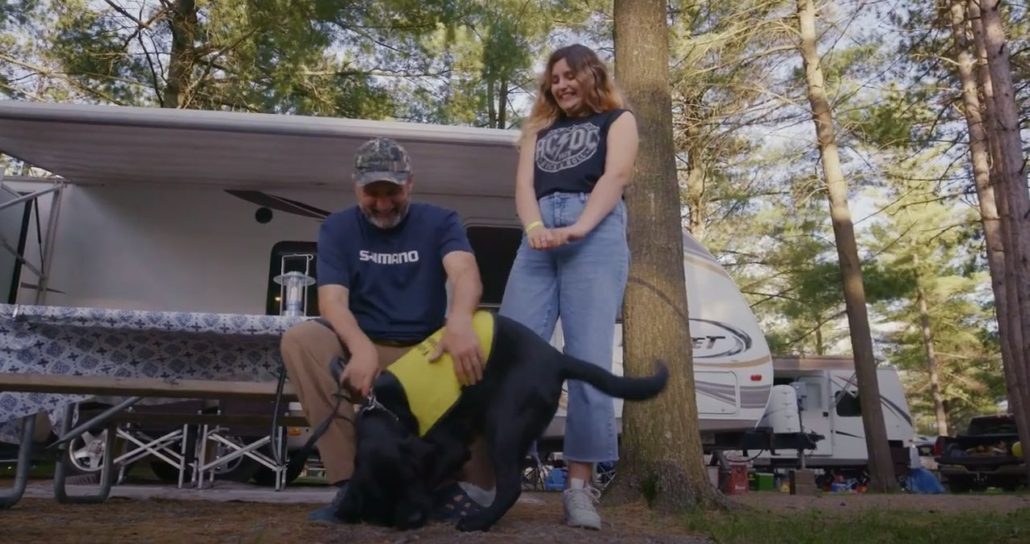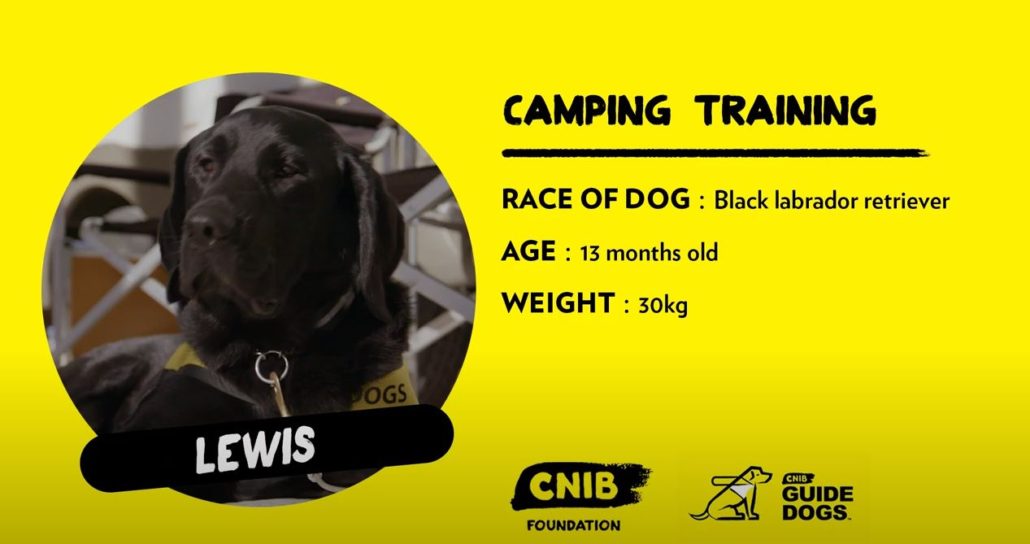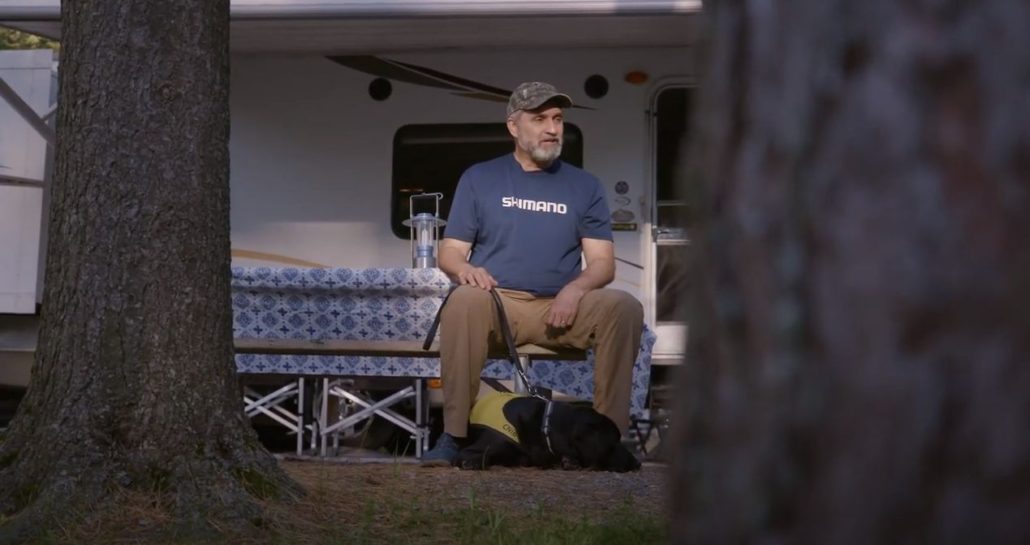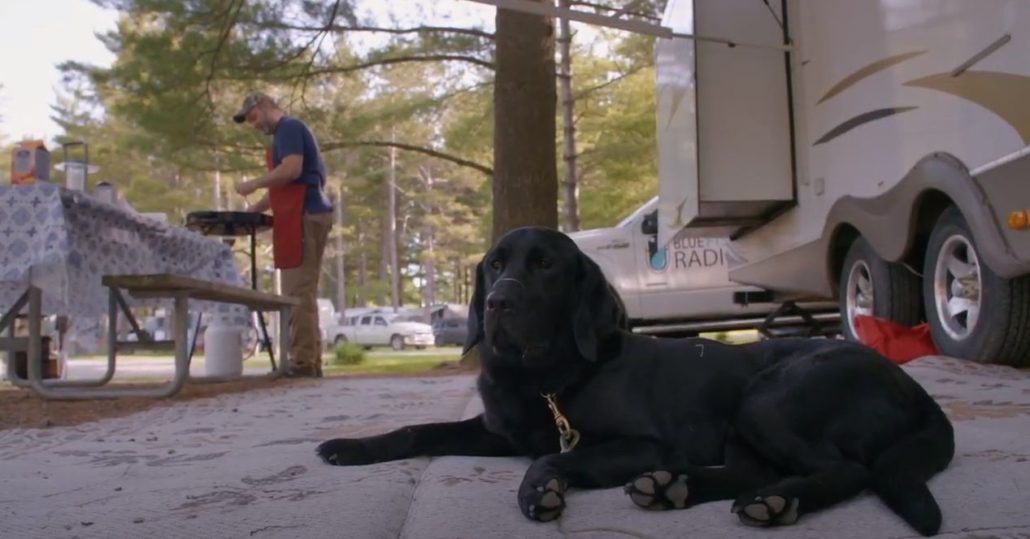Episode 7: Camping
My wife Anne and I enjoy taking off in the summer with our travel trailer and exploring Canada and the United States. We spend on average 35 nights a year camping. There are a few campgrounds that we return to annually, like the Cardinal KOA located near-by the St. Lawrence River – a favourite of our two youngest, Theo and Lilly. Mostly, though, we just travel. Our longest trip on record so far took nine weeks and covered just over 16,000 kilometers.
Our kids also enjoy these adventures. As a family, being all in one vehicle or in one long 29-foot camper with bunks at one end, a full bathroom, kitchen, dinette and sofa amidships, and a queen bed upfront for the parents, it means we all need to get along. Because there’s no alternative! No doors to retreat behind. Things are said, stuff comes out, we deal with it, and then the rest of the trip always goes amazingly well.
Our half-ton Ford 150 has a small but powerful motor and lots of room in the backseat for 2-3 people to sprawl out and for a big guide dog or two to stretch and rest comfortably. There’s actually way more room in the back seat then there is up front. I keep a splash-proof water bowl purchased from Camping World for the dogs in the truck at all times, and we make plenty of short stops on route when the dogs can come out on leash and stretch their legs.
Naturally, my wife Anne does all the driving. I’m in charge of prepping the trailer and for all the exterior connectivity (hydro, water, sewage), and setting up the mats, chairs, awning, lights, and lots more. And then putting it all away again when it’s time to pack up.
Based on years of experience we have the routine down. When we arrive somewhere new, other campers always note that there’s a woman behind the wheel and a man sitting in the passenger seat. We know that I’m not to exit the truck until Anne has the trailer backed into the campsite and ready to unhook. If I get out of the truck with my white cane before the trailer is properly situated, inevitably other campers will come over to help Anne, offering all manner of well-intentioned but often confusing directions on how best to back up the trailer. As if she has never done that before. It can get more than a bit silly when two or more well-meaning fellow campers start calling out directions from their various perspectives. Needless-to-say, everyone is thoroughly impressed with Anne’s truck-trailer reversing abilities – she’s one of the best.
It was my hope to bring two or three of the dog guide trainees with us camping for four days, but given their training schedule and as they were entering the final phase of their training, we had to settle for just the one: Lewis. I like Lewis, but he just seems like a bit of a joker. He’s always looking to have fun, to chew on things, to play with other dogs, to play with me or the kids, to dig holes and then chew some more. In so many ways, he is just a typical Labrador. I can never imagine him as a trained guide dog.
Even so, I can also say the same thing for the rest of the dogs that I met and worked with during the past six months. Meeting them at 12 months of age really brings home the message that guide dogs start off as puppies, yes, but also as young dogs who are happy just being dogs. It’s hard to conceive that by the time these trainees are 18-20 months old they will be fully-skilled guide dogs.
I understand that all dogs need to have a job. Nothing undermines a dog’s confidence and sense of self-worth more than being made to feel superfluous. It goes way back to their pack mentality. A pack of dogs works together for the good of the pack, not for their own personal enrichment. Dogs that are seen to be unable or unwilling to pull their weight are forced out of the pack.
Whether it’s walking around the neighbourhood in the morning or afternoon to scout the territory for potential threats or newcomers, or meeting the kids at the bus stop, they all find meaning in what they do. In my case, it’s leaving the home with me and getting back in one piece.
I used to think my guide dogs knew I was blind and that their job was to help be with my mobility. Some very smart guide dog trainers proved to me that dogs really don’t know about blindness. They only know that if they don’t pull or push me in certain directions I’ll bang into things or fall down. They forget about trying to make eye contact with me after about two days following our meeting. That doesn’t mean they know I can’t see, just that I’m not interested in eye contact.
I know when my guide dog directs me around an obstacle or helps me find a door or step, that they aren’t looking for praise. It’s just the two of us working together as we carry out our mission away from home. What gives my dog a sense of satisfaction is when we return home. The dog barks at me, wants to wrestle, licks my face and ears, and is in the best mood of the day. And so am I.
Now I’m not sure how many people are familiar with campgrounds meant for recreational vehicles (RV’s), but the general approach is to pack them in good and tight. KOA campgrounds are some of the nicest in North America in terms of site quality, cleanliness, amenities, and activities for the entire family. We’ve been visiting the KOA in Cardinal for over 12 years. There’s another thing that campgrounds share in common: probably half the campers, at least, bring dogs.
Every evening after dinner and before we light the fire, Anne and I enjoy going for a walk through the campground. It’s interesting to observe how other people camp and the kinds of equipment they bring along. Walking with a dog is also a great way to break the ice, which is also part of camping: meeting new people. Having my dog in harness also lets everyone know that my dog is not a pet but a guide dog and that I’m blind, two important pieces of information people need to know if they want to avoid uncomfortable situations from arising. All this to say, my guide dog is still a dog and is always going to stimulate a lot of barking from other dogs that are tied up at their campground.
A good guide dog knows how to demonstrate a confident yet disinterested pose when encountering other campground dogs. They shouldn’t be straining at the harness to go visit the other dogs and do all the doggy things dogs do when meeting another dog for the first time. This is really tough, but essential if a blind person is ever going to get where we want to go. We can’t be stopping each time we encounter another dog. It’s also a safety issue. Having a guide dog fixated on another dog can lead to all sorts of trouble when they fail to let me know about a potential obstacle.
Most people understand that guide dogs are working when they are in their harness, and when they drop by our camp site, they already know that my dog is an actual guide dog. I prefer if people reframe from paying a lot of attention to my dog, but some people just can’t help themselves. There’s a fine balance between a dog getting attention, and a dog having their ego becoming a bit to inflated.
The last thing any blind person wants is their guide dog to think that they are way more popular and have many more friends than the person they are guiding. This leads to an imbalance in the partnership, one that’s incredibly difficult to restore. It can lead to the dog thinking it can start to make the really important decisions such as when it’s time to work, or what direction should be taken. Dogs are also naturally lazy, so if a guide dog starts to think it no longer needs to work because it has other more important friends, good luck ever regaining that respect.
Back to the campground. My guide dogs always love being outside. I bring a 20-foot leash that allows them to move about freely throughout our site, but not too much leash that would make it possible for them to visit our neighbours, or to get tangled in among camp chairs. As long as the dog can come sit next to me, is comfortable with a good view, and can get out of the sun or rain, that’s all that counts.
All campgrounds these days are dog friendly. Most even have dog playgrounds. They want you to keep your dog on a leash at your campsite, and not to leave the dog tied up outside your camper when you’re not around. Other than that, dogs of all sizes and breeds are now welcome.
My dogs figure out pretty quickly that lying under the camper is the best. They can see out 360 degrees, and the smells rolling across the ground can be monitored from all directions. It’s cool, and secure. Like their very own cave or den.
If we need to go somewhere like the beach where bringing a dog may not be the best idea (or not permitted), we simply leave our dogs inside the camper. During the day we will open up the windows to create a cross breeze and lower the blinds on the side of the trailer that will get the afternoon sun. Plug in the fans, turn on some music, fill up the water bowl, and they are fine. They can see out the windows and hear everything. The camper really does become our rolling shared high-end doghouse.
If there are going to be fireworks in the evening, we put the dogs into the camper, close all the windows and doors, and put the music on sufficiently loud as to block most of the noise coming from the fireworks display. Some of the toughest guide dogs I’ve had were afraid of thunder and fireworks, while others pay them no mind.
I don’t do any of the above when camping using tents. For tent camping, the dog is with me at all times. Also, I never leave the dog in the trailer with the windows closed on a hot day and leave the air conditioning running. You never know if there’s going to be a power outage and the AC fails.
Knowing how to keep any dog’s excitement level under control is important. Campgrounds are good tests for learning and trialing these skills. With so many people and dogs walking about, all the smells and sounds, and everyone outside, it’s doggy heaven for most dogs. However, an excited guide dog isn’t necessarily a competent guide dog. Yes, there is times when it’s important for a guide dog to put on his/her game face, since nothing is worse than working with a guide dog that’s asleep at the switch. But, the guide dogs I generally get matched with have more than their fair share of energy. Building up energy before heading out is never an issue. Keeping energy levels under control is the challenge. No one is safe when a guide dog begins its walks as if they are a short track sprinter.
Generally, I don’t let my guide dogs run with other dogs at dog parks, though sometimes this can’t be avoided. Giving my dog a chance to burn off excess energy is not my problem. We walk on average between four and six kilometers a day, so stopping at a dog park so my guide dog can frolic with other dogs may be fun for the dog, but I find can lead to expectations on the dog’s part that running with the pack is always going to be part of every outing. They don’t understand when you are trying to get somewhere and there’s no time for doggy playtime. It’s just easier to provide the exercise and mental stimulation through spending a day at my side in the harness.
Guide dogs learn to love the work and feel proud about the job they do each and every day. Their reward is getting you home at the end-of-the-day safe-and-sound. It’s not the same as a pet that gets out of the house for a couple walks a day to the dog park and back to burn off energy and spends most of their day home alone.
Dogs also like predictability. They like their day well organized. You can change their route, or stretch out or shorten a day, but a happy dog has a routine. Adding or subtracting things that bring a dog pleasure can be difficult for a dog to understand. Constancy is the ticket to a happy dog.
During our adventures together I have discovered that Lewis is a truly gentle soul. But he’s also young and has a curious and playful spirit. He would love to visit every dog in this campground. Whether it’s his more alpha personality, or if it has something to do with the way he was raised, it just seemed like Lewis wanted to meet and play with all the dogs in this campground. He’s not the easiest to walk with using the leash, which makes me wonder what he would be like in an actual guide dog harness.
In the past, I’ve had guide dogs that I’ve had to speed up, and others that I’ve had to slow down. Both situations can be difficult to achieve, as their speed is tied to each dog’s unique personality. Finding a dog that walks the same speed as you is the goal, but difficult to achieve. Plus, there are times in the day and different circumstances when a dog may need to walk faster or slower than normal. Being able to manage distraction and speed are two sides of the same coin.
Looking back, I’d say that we had a relaxing camping trip. It turned out Lewis settled in nicely and enjoyed his camping experience. The only thing we found quite unusual was his inability to be on a long leash without getting it tangled around his feet. The first time we clipped him on to the leash at the trailer it took him about 15 minutes before he had completely hog-tied himself, all four paws wrapped up, and Lewis disabled on his side. I switched from the leash I’ve been using for the past 20 years to a bungie that I had made for our daughter when she was two years old and kept wondering off herself at the campground. She had a little harness as well, but she sure didn’t like being tied up. The cord worked well for Lewis, but I doubt he’ll ever master the use of his paws well enough to keep from getting wrapped and for using them to unwarp himself. This is quite unusual, and it makes me wonder just how solid he will be as a guide dog.

